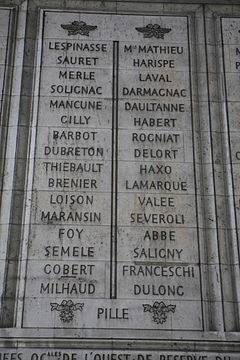Augustin de Lespinasse
Augustin de Lespinasse | |
|---|---|
General of Division | |
| Battles/wars |
|
| Awards | Count of the Empire, 1808 , 1814Chamber of Peers |
Augustin de Lespinasse (8 October 1737 – 23 November 1816) commanded French artillery during the
Lespinasse transferred to the
Early career
Lespinasse was born in
Lespinasse had been promoted to captain on 24 March 1767. Other officers were jealous of his promotion and he was obliged to fight a number of duels in which he showed himself courageous and generous. He was attached to the fortress of Strasbourg and became inspector of the weapons manufacturers at Saint-Étienne and Maubeuge. On 25 May 1788 he received promotion to major and put in charge of setting up an artillery depot on the Loire River, but the French Revolution ended that project.[1]
French Revolution
On 1 January 1791 Lespinasse was promoted colonel of the 5th Foot Artillery Regiment. On 26 March 1793 he became

The French built the Sans Culottes Camp covering the village of Urrugne near the Bay of Biscay.[5] The camp was used as a place to train new conscripts.[6] One notable feature of the Sans Culottes Camp was that the soldiers lived in huts instead of tents. Jacques Léonard Muller organized his army into 40 battalions in five divisions, despite having to send 8,000 troops to other armies in January 1794. The 26 best battalions were distributed among the front-line divisions of Jean Henri Guy Nicolas de Frégeville, Bon-Adrien Jeannot de Moncey and Henri François Delaborde while the remaining 14 were parceled out to the divisions of Jean-Antoine Marbot and Jean Mauco.[7] Lespinasse was in charge of building fortifications during the winter. These earthworks consisted of forts connected by breastworks. The entire front from Hendaye to the sources of the Nive River was covered by mutually-supporting redoubts.[6]
The Spanish army consisted of 20,000 troops of whom half were militia.
The Spanish columns carried the Croix des Bouquets and the Calvaire in their initial rush. From the Croix they took the Sans Culottes Camp under artillery fire. The local French commander Frégeville was not present but Lespinasse took charge. Sacrificing his outlying positions he concentrated his strength at the Redoubt de la Liberté and a bitter fight ensued. A unit of French marines suffered heavy losses while on the other side the Irish Regiment of Ultonia was roughly handled. With the Spanish advance checked, Frégeville arrived on the scene
At the insistence of the
The Minister of War did not recognize Lespinasse's rank and refused to employ him for a time. Ultimately he transferred to the
Empire
Emperor Napoleon named Lespinasse a Grand Officer of the
Notes

- Footnotes
- ^ Mullié gave the year 1769 but the chronology suggested this is certainly a misprint for 1759.
- Citations
- ^ a b c d e f g h i j k l Mullié 1852, pp. 217–218.
- ^ a b c d e f Broughton 2007.
- ^ Smith 1998, p. 41.
- ^ Phipps 2011a, p. 135.
- ^ Cust 1859, p. 172.
- ^ a b c d Cust 1859, p. 233.
- ^ a b Phipps 2011a, p. 149.
- ^ a b Smith 1998, p. 72.
- ^ Cust 1859, p. 234.
- ^ a b Smith 1998, p. 88.
- ^ a b Phipps 2011a, pp. 186–187.
- ^ Cust 1859, p. 266.
- ^ Phipps 2011b, p. 59.
- ^ Phipps 2011b, p. 220.
- ^ Association du Père-Lachaise 2008.
References
- Broughton, Tony (2007). "Generals Who Served in the French Army during the Period: 1789-1814, Lemaire to Lynch". The Napoleon Series. Retrieved 11 May 2015.
- Cust, Edward (1859). "Annals of the Wars: 1783-1795". Retrieved 11 May 2015.
- "LESPINASSE Augustin, comte de (1736-1816)" (in French). Association des Amis et Passionnés du Père-Lachaise. 2008. Retrieved 16 May 2015.
- Mullié, Charles (1852). Biographie des célébrités militaires des armées de terre et de mer de 1789 a 1850 (in French). Paris. Retrieved 13 May 2015.
{{cite book}}: CS1 maint: location missing publisher (link) - ISBN 978-1-908692-26-9.
- ISBN 978-1-908692-27-6.
- ISBN 1-85367-276-9.
